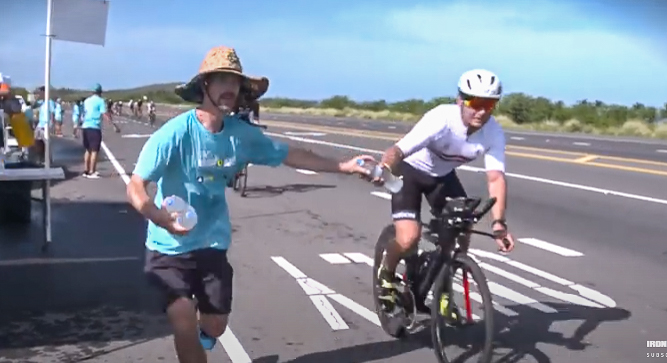With the Ironman World Championship in Kailua-Kona less than a week away, race organizers are scrambling to find volunteers to fill about 4,000 shifts to help care for the approximately 5,000 participants.
In the past, about 6,000 volunteers were needed to make the 17-hour, 140.6-mile swim, run and bike race operate smoothly on the Big Island. But with the transition this year to a two-day format to accommodate more triathletes, the number of volunteers needed has increased to about 8,000.
With two races, there are now 10,000 shifts to fill, according to Franz Weber, director of the Ohana Information Center.

“We still have about 4,000 open spots, but that number is a bit flexible because we might have a group that signs up, and 50 spots will be filled,” Weber said Friday. “Right now, we have about 150 people signing up every day, so that number changes quickly.”
There are more than 185 different volunteer jobs to choose from, including handing out water, guiding someone on the course and taking off participant’s time chips at the finish line.
The organizers also are looking for volunteers to clean up the bike course, check in people at the finish line, catch people at the finish line and work in the warehouse. Bike mechanics and motorcycle drivers for marshals also are needed.
“There’s a lot to choose from,” Weber said. “For example, a swim volunteer could be on a paddle board as a swim patrol in the water making sure swimmers are safe. We also have people in the water helping guide them up the stairs.”
On the volunteer page of the Ironman website, people can sign up for specific duties and time slots. Each job has a description.
For example, 10 spots are left to work as a “Finisher Midnight Ambassador” for the first race and six for the second race. These ambassadors work 10:30 p.m. to 2 a.m., providing extra support and comfort to finishers after 11.30 p.m., assisting with logistics, gathering race gear, getting food and fluids and helping with communication.
Volunteers fly in from all over the world to help with the world-class event that will hold the women’s race on Oct. 6 and the men’s race on Oct. 8. Shifts run three to four hours.
“People come from New Zealand. They come from Oahu. They travel from all over to be part of it,” Weber said. “I would say we have more volunteers than ever before flying in this year.”
Weber said there already are about 1,000 more volunteers signed up for the 2022 event compared to the number who helped out in 2019, the last time the Ironman was held on the BIg Island due to a hiatus caused by the COVID-19 pandemic.
But it’s not enough volunteers to fulfill the needs for the two-day format. To help fill the void, many volunteers have taken on multiple shifts.
“Our volunteers are the heart and soul of this event,” said Kerstin Blunt, Director of Volunteer Management. “Without them there’s no way we can pull off what we have in the past. And this year, a lot of our volunteers are doing several shifts. Which is great. It shows their commitment. That they’re interested in helping. That they’re supporting the athletes. They’re staying longer to do a little more.”
Also to compensate for the volunteer shortage, there will be slightly fewer aid stations spread along the biking and running routes than in past races.
“We will have nine aid stations on the bike course and eighteen on the run,” Cobb said.
This means aid stations will be every 1.6 miles instead of every 1 mile on the run course; and there will be aid stations every 10 miles on the bike course instead of every 7 miles.
There also will be a medical team of about 400 volunteers to assist athletes with injuries, dehydration and other health issues.
Non-profits have provided a significant number of volunteers this year, including about 80 school groups, church groups and sports groups.
Many Big Island residents have volunteered for the Ironman year after year, including Sheryl Cobb, who has donated her time to 25 Ironman World Championships. This year, she is the Aid Station Director.
She said the volunteers enjoy helping the athletes accomplish their dreams, “and that’s no small feat.”
Jan War, who has been volunteering with Ironman since 1987 and is now the Swim Director, recalled one year when a severe rain storm hit Kailua-Kona on race day.
“Back in the late 80s we had a major rain storm,” he said. “Roads were flooded race morning. We had an emergency meeting at 4 a.m and they asked me if things were gonna be ok. And I looked out at the beach and saw the water patrol people on the beach. So we decided the race was doable.”
“Eventually the rain stopped but it rained pretty hard. Luckily, there was no lightening. But lots of rain and wind. Fourteen people dropped out that year. Which is a record.”
Mike Drutar, who has been volunteering with Ironman since 2011, is now the Finish Line Director. He said: “It’s very exciting to see how many people in our community come out to support the athletes for hours on end. When it’s hot, you’re dealing with sweaty athletes.
“It’s not always easy. But you also get to see athletes who have overcome difficult situations — people who have overcome cancer and weight issues and pushed past those obstacles. It’s very inspirational.”
Drutar recalled the time he had to escort a woman, whom he thinks was from England, off the course after she missed the time cut.
“She was pretty upset,” he said. “But then the next year, she completed the entire race. That was cool to see someone go from a rough spot and didn’t make the time cut and then had the fight to come back and finish the next year.”
